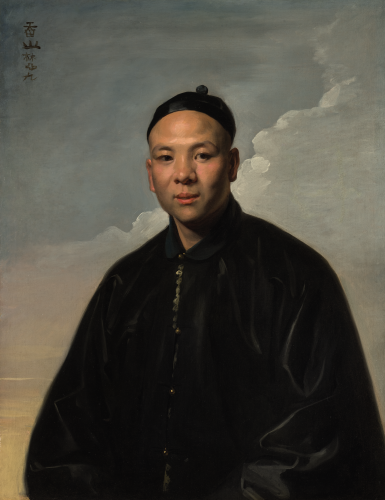
HENRI-PIERRE DANLOUX | PORTRAIT OF LUM A'KAO
Auction Closed
January 30, 12:05 AM GMT
Estimate
400,000 - 600,000 USD
Lot Details
Description
HENRI-PIERRE DANLOUX
Paris 1753 - 1809
PORTRAIT OF LUM A'KAO
inscribed upper left in Chinese script: 香山林亞九
oil on canvas
35¼ by 28 in.; 92 by 71 cm.
Collection of the artist and by descent to his son, in whose possession still in 1860;
Anonymous sale (‘Mme X’), Paris, Galerie Charpentier, 31 March 1938, reproduced;
Baronne Cassel van Doorn;
Her sale, Paris, Galerie Charpentier, 30 May 1956, lot 29;
Hubert de Givenchy (b. 1927), fashion designer and founder of The House of Givenchy, until 1997;
From whom acquired by a private collector, Ireland;
From whom acquired.
Paris, 26, Boulevard des Italiens, Tableaux et dessins de l’école française, principalement du XVIIIe siècle, tirés de collections d’amateurs, November 1860, no. 371.
Dictionnaire général des artistes de l’école française…, E. Bellier de la Chavignerie and L. Auvray (eds), vol. 1, Paris 1882, p. 336;
R. Portalis, Henri-Pierre Danloux, peintre de portraits et son journal durant l’émigration (Paris 1753–1809), Paris 1910, p. 202, reproduced on p. 204, after Grozer’s print;
C. de Constant, Récit de trois voyages à la Chine (1779–1793), P. de Vargas (ed.), Peking 1939, p. 10 and pp. 41–43.
Engraved
Joseph Grozer (c. 1755–1798), mezzotint
A rare instance of an eighteenth-century portrait of a Chinese sitter by a European artist, this highly unusual painting depicts Lum A’Kao, who came to London in 1793 from Canton as the attendant of Charles Constant de Rebecque (1762–1835), a swiss-born merchant and banker who travelled extensively with the East India Company, including three voyages to China between 1779 and 1793, After executing his portrait of A’Kao, Danloux had it published as a print by Joseph Grozer.1 Grozer’s mezzotint is lettered below the image with a dedication to ‘Mr. Chas. Constant de Rebecque’. Both the portrait and the print are datable to 1793.
The Chinese characters inscribed in the upper left corner of the painting were probably by Danloux himself, their lack of fluidity perhaps due to his unfamiliarity with Chinese script and his use of a brush laden with paint rather than ink. The first two characters, Pan Shan in Mandarin, signify the place where the sitter is from, a town in the province of Canton; the third character, Lin in Mandarin is the sitter’s surname (Lum or Lam in Cantonese); the last two characters, Ya Jiu in Mandarin or A’Kao in Cantonese, is his informal name, used as a familiar or private term. Thus Lum A’Kao written as 林亞九 is his name in Cantonese and 番山 (or 香山, depending on how the first character is deciphered) corresponds with Euhun Sang, the place name adopted in the print.
Constant de Rebecque was an old friend of Danloux, a connection which might explain how the portrait came to be painted. The relationship between the sitter and Constant de Rebecque is confirmed by Danloux’s wife, Marie-Pierrette-Antoinette de Saint-Redan (1765–1844), who later noted that she had received a letter from Mme de Sérilly, a family friend, brought to her by Lum A'Kao, the man whom her husband had painted.2
Danloux trained in the studio of Joseph-Marie Vien (1716–1809), the French academic painter and promoter of neo-classical ideals, whose pupils in the 1770s included the man who would become the pre-eminent painter of the French Republic, Jacques-Louis David (1748–1825). In 1775 Danloux, like David, followed Vien to Rome on his teacher’s appointment to the directorship of the Académie de France. While in Italy he traveled to different artistic centers, already showing a talent for portraiture and a predilection in his work for informality and intimacy. Danloux left Italy in 1783, though he was to return to Rome later in the decade, settling in Lyon before moving to Paris two years later. In the capital, his sitters were largely the aristocracy, foremost among them members of the royal family – Mme Elisabeth and the Dauphin – whose portraits he was commissioned to paint the very same year that the regime crumbled. Danloux remained loyal to the monarchy, emigrating to London in 1792.
Danloux lived through a period of unparalleled social and political upheaval. In Paris his sitters were largely members of the aristocracy. His work there shows a predilection for informality and intimacy. In 1792 he emigrated to London. While in exile in Britain during the tumultuous years in the aftermath of the French Revolution, he found a receptive clientele among the French émigré community and obtained from them notable portrait commissions. He excelled in family group portraits and portraits of children, and moved towards a more restrained elegance in his work. He exhibited at the Royal Academy in 1793, the same year that he painted this portrait of Lum A’Kao. Of the portraits executed by Danloux during his stay in London, the present painting is undoubtedly one of the most remarkable due to its exceptionally high quality and its appropriately spare evocation of the appearance of this foreign sitter.
In 1801, during Napoleon Bonaparte’s rule as First Consul, Danloux was back in Paris, where he painted fewer portraits and instead turned his attention to painting history subjects, with mixed success. His greatest achievements were in the realm of portraiture. He also continued with the series of portraits of artists and figures from the theater that he had begun before the Revolution.
1. Dominique Vivant, Baron Denon (1747–1825), writer, diplomat, and the first Director of the Louvre Museum, is known to have owned an impression.
2. De Portalis 1910, p. 202.
